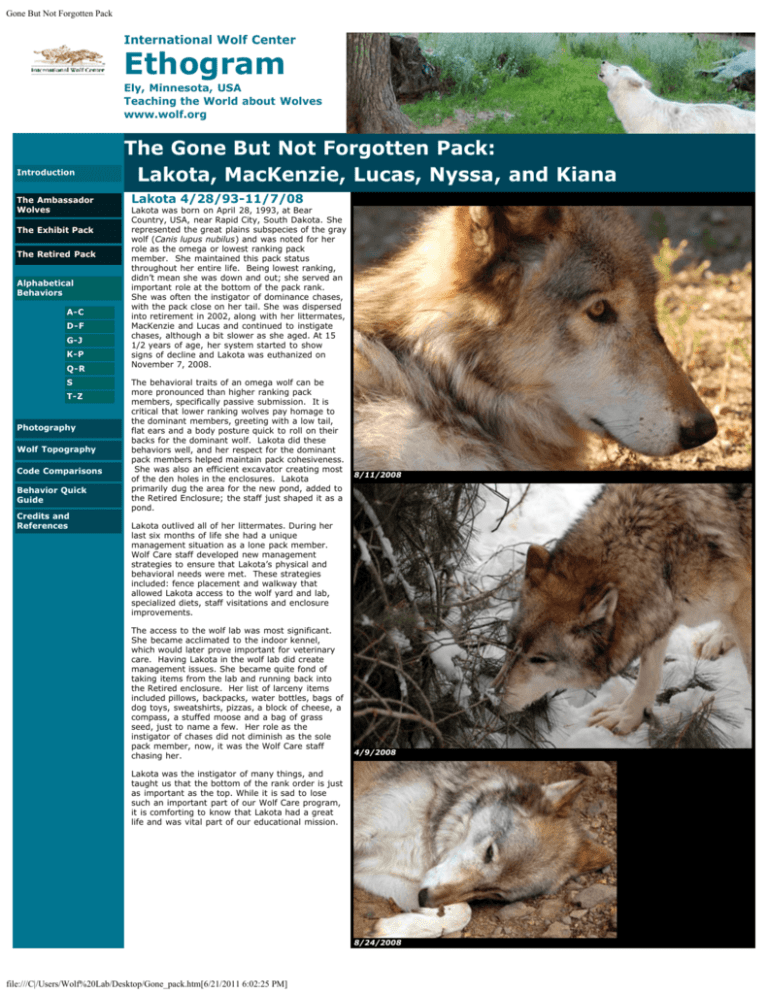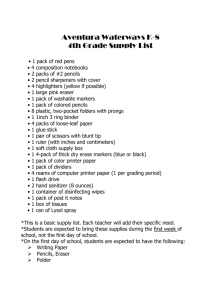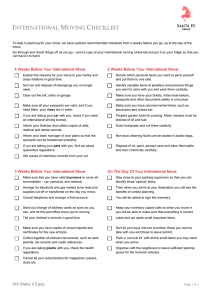
Gone But Not Forgotten Pack
International Wolf Center
Ethogram
Ely, Minnesota, USA
Teaching the World about Wolves
www.wolf.org
Introduction
The Ambassador
Wolves
The Gone But Not Forgotten Pack:
Lakota, MacKenzie, Lucas, Nyssa, and Kiana
Lakota 4/28/93-11/7/08
Lakota was born on April 28, 1993, at Bear
Country, USA, near Rapid City, South Dakota. She
represented the great plains subspecies of the gray
wolf (Canis lupus nubilus) and was noted for her
role as the omega or lowest ranking pack
member. She maintained this pack status
throughout her entire life. Being lowest ranking,
didn’t mean she was down and out; she served an
important role at the bottom of the pack rank. She was often the instigator of dominance chases,
with the pack close on her tail. She was dispersed
into retirement in 2002, along with her littermates,
MacKenzie and Lucas and continued to instigate
chases, although a bit slower as she aged. At 15
1/2 years of age, her system started to show
signs of decline and Lakota was euthanized on
November 7, 2008.
The Exhibit Pack
The Retired Pack
Alphabetical
Behaviors
A-C
D-F
G-J
K-P
Q-R
S
T-Z
Photography
Wolf Topography
Code Comparisons
Behavior Quick
Guide
Credits and
References
The behavioral traits of an omega wolf can be
more pronounced than higher ranking pack
members, specifically passive submission. It is
critical that lower ranking wolves pay homage to
the dominant members, greeting with a low tail,
flat ears and a body posture quick to roll on their
backs for the dominant wolf. Lakota did these
behaviors well, and her respect for the dominant
pack members helped maintain pack cohesiveness.
She was also an efficient excavator creating most
8/11/2008
of the den holes in the enclosures. Lakota
primarily dug the area for the new pond, added to the Retired Enclosure; the staff just shaped it as a
pond.
Lakota outlived all of her littermates. During her
last six months of life she had a unique
management situation as a lone pack member. Wolf Care staff developed new management
strategies to ensure that Lakota’s physical and
behavioral needs were met. These strategies
included: fence placement and walkway that
allowed Lakota access to the wolf yard and lab,
specialized diets, staff visitations and enclosure
improvements. The access to the wolf lab was most significant.
She became acclimated to the indoor kennel,
which would later prove important for veterinary
care. Having Lakota in the wolf lab did create
management issues. She became quite fond of
taking items from the lab and running back into
the Retired enclosure. Her list of larceny items
included pillows, backpacks, water bottles, bags of
dog toys, sweatshirts, pizzas, a block of cheese, a
compass, a stuffed moose and a bag of grass
seed, just to name a few. Her role as the
instigator of chases did not diminish as the sole
pack member, now, it was the Wolf Care staff
chasing her.
Lakota was the instigator of many things, and
taught us that the bottom of the rank order is just
as important as the top. While it is sad to lose
such an important part of our Wolf Care program,
it is comforting to know that Lakota had a great
life and was vital part of our educational mission.
4/9/2008
8/24/2008
file:///C|/Users/Wolf%20Lab/Desktop/Gone_pack.htm[6/21/2011 6:02:25 PM]
Gone But Not Forgotten Pack
3/13/2008
4/20/2007
2/15/1995
6/14/2006
9/8/2006
5/26/1993
5/16/2006
3/5/2007
7/24/2006
file:///C|/Users/Wolf%20Lab/Desktop/Gone_pack.htm[6/21/2011 6:02:25 PM]
6/28/2006
Gone But Not Forgotten Pack
4/3/97
1/2/2007
1/2/2006
6/29/2008
7/5/2008
MacKenzie:4/28/93-5/21/08
9/8/2008
Back to Top
time in the lab
Spending
7/24/2008
MacKenzie, was born on April 28, 1993, at Bear
Country, USA, near Rapid City, South Dakota. She
represented the great plains subspecies of the gray
wolf (Canis lupus nubilus), and was noted for her
striking black pelage and her intent ears pricked
forward in an alert posture. MacKenzie was the
dominant female in the Exhibit Pack until Shadow,
one of the arctic pups supplanted her. She was
dispersed into retirement and established the
dominant female status with the retired pack until
she died on May 21, 2008. The behavioral traits of a dominant wolf can be
much more intense than that of lower ranking pack
members. Pack leadership includes not only
defending the territory, but establishing strong
social bonds to maintain pack cohesiveness.
MacKenzie’s dominance and nurturing qualities
9/8/1998
were observed during the August 9, 2000 wolf pup
introduction. The behavior logs for that day read
as follows:
“Pups are choosing to sleep near MacKenzie
(ranging from 6 inches to 5 feet distance) and
file:///C|/Users/Wolf%20Lab/Desktop/Gone_pack.htm[6/21/2011 6:02:25 PM]
Gone But Not Forgotten Pack
sometimes Lucas. Pups appear to run to
Mackenzie when fearful or when being chased by
Lakota and Lucas. Generally, when the pups are
restless, Mackenzie whines and approaches the
pups until they lay down, at which time, she
circles them and then lies down in the same
general area.
5/20/2006
Several times during the observation shift, after
MacKenzie demonstrated this behavior, Lucas
attempted to approach and Mackenzie stood up
flattened her ears and Lucas retreated. During one
of the encounters, MacKenzie curled her lip and
barred her teeth at Lucas, again he retreated
rather than approaching the pups.”
9/14/1997
MacKenzie was the matriarch of this facility who
taught us so much about wolf behavior, dignity,
dominance status and retirement.
6/4/2006
12/12/2005
2/13/2006
Lucas:4/28/93 - 7/11/06
3/12/2006
Back to Top
2/22/2006
4/3/2006
Lucas was born on April 28, 1993, at Bear
Country, USA, near Rapid City, South Dakota. He
represented the great plains subspecies of the gray
wolf (Canis lupus nubilus), and was noted for his
very calm personality, lack of strong dominance
behavior and tall, striking appearance. For the
first seven years of his life, he was the only male
in a pack of females. Since rank order is genderspecific for wolves, Lucas, as the only male,
became the dominant male by default. He was
very laid back since he had no other male to
challenge him. A laid back animal is easier to
manage.
But Lucas tried hard to fill his dominant role, and
he provided great behavioral data while doing it. Missing the challenge of another male, he created
his own assertion of authority. Often ignored by
the females, Lucas would display a stand over
behavior to his littermates. In this situation, one
wolf stands directly on top of another wolf that is
lying down. In some cases, there may be other
postures or eye contact, but in Lucas’s case, he
just stood there, and the females usually averted
their gaze or just got up and left. One of staff’s best memories of Lucas is the way
he exerted authority during feeding time. On
numerous occasions, when a roadkill deer was
placed in the wolf enclosure, Lucas would pick up
the head, set it down in front of his packmates,
and growl. He also stars in an infamous video clip
demonstrating a foreleg stab, where he taunts
young Shadow (four months old at the time) to
leave his deer carcass and chase him.
6/16/2004
12/5/2005
11/29/2003
On July 11, 2006, Lucas joined another pack at the
Center: “The Gone But Not Forgotten” pack. He
5/15/2005
was euthanized when it was clear he would not
recover from a chronic, degenerative spinal
condition and age-related issues. Wolf Care staff
members commented:
“He was a dignified animal. He always held his
head up high,” even as his legs gave out on the
file:///C|/Users/Wolf%20Lab/Desktop/Gone_pack.htm[6/21/2011 6:02:25 PM]
Gone But Not Forgotten Pack
Tuesday afternoon of his death. The staff strived
to make the end of his 13-year life “as dignified as
possible” and were with him until the end.
6/14/2006
5/10/2004
2/5/1998
Nyssa: 5/12/04–5/11/05
4/10/2006
Back to Top
Nyssa was one of three pups acquired from the
Minnesota Wildlife Connection in Sandstone,
Minnesota in May, 2004. Nyssa was raised with
two pups that were one week older, and not true
littermates, but had a genetic tie. The two females
that whelped the pups were siblings. All three pups
were great plains subspecies of the gray wolf,
(Canis lupus nubilus) although Nyssa was unique
with a black pelage. Because Nyssa was a week
younger, staff and volunteers were concerned
Nyssa wouldn’t be able to keep up with the older
pups, but behavioral observations quickly dispelled
that concern. Many hours of observation
file:///C|/Users/Wolf%20Lab/Desktop/Gone_pack.htm[6/21/2011 6:02:25 PM]
2/1/2006
1/2/2006
1/14/2005
1/9/2006
Gone But Not Forgotten Pack
demonstrated that spirit is not about size, it’s
about attitude and Nyssa had plenty of that.
The loss of this member of the Gone but Not
Forgotten Pack is the most difficult for Wolf Care
staff. All the others lived full lives, some longer
than others, but all surpassed the average age of
mortality for wild wolves. Nyssa was just a yearling
at the time of her death. Nyssa and Maya had been spayed and were kept
separate from the rest of the pack to give the
yearlings time to heal. It is difficult to assess how
long to isolate an individual for surgical recovery.
Wolves are social animals, and separation from the 1/29/2005
pack can lead to destructive behavior as they
climb and chew fences to get back to each other.
Alternately, the pack may perceive that the wolf
separated for a medical procedure has dispersed,
and can close ranks, becoming aggressive when
the other returns. When the wolves became
extremely agitated at the separation, the females
were allowed back into the main enclosure with the
rest of the pack and were put under a 24-hour
watch by handlers. Five days after the surgery the incisions on the two females were healing well,
with sutures still in place. The next morning Nyssa
was found with her incision open. An exuberant
run or a jump across the pond could have popped
a stitch, causing bleeding and drawing her and the
other wolves’ attention to the suture site. The
suture had only opened an inch, but her injuries
were severe. On May 11, 2005, at one day less
than a year of age, Nyssa was euthanized. We are
3/12/2005
reminded by an article on the Center’s Web site at wolf.org that the second leading cause of wolf
mortality is wolf-on-wolf aggression.
3/12/2005
3/1/2005
9/29/2004
7/18/2004
3/12/2005
file:///C|/Users/Wolf%20Lab/Desktop/Gone_pack.htm[6/21/2011 6:02:25 PM]
Gone But Not Forgotten Pack
6/16/2004
Kiana: 4/28/93 - 12/26/98
1/13/2005
Back to Top
Kiana, was born on April 28, 1993 at Bear Country,
USA, near Rapid City, South Dakota. She
represented the great plains subspecies of the gray
wolf (Canis lupus nubilus), and was noted for her
intense eye stare and pronounced almond-shaped
eyes. Kiana was a strong social pack member that
had an intense bond with MacKenzie, the dominant
female. She would willingly submit to MacKenzie
without question, never challenging or showing
any indication that she wanted to move up in
rank.
Kiana was also noted for her heightened
aggression toward Lakota. She more intensely
dominated the omega wolf than did MacKenzie.
Often, MacKenzie stood back observing Kiana
pinning Lakota. When MacKenzie approached,
Kiana submitted to her, rolling her head to the
side, flattening her ears and licking MacKenzie's
muzzle. Kiana was wary of strangers who came
near the wolf yard and would retreat to the woods
line to stare at them from between the branches.
1/17/2005
1/13/2005
On December 26, 1998, Center staff announced
the death of Kiana, the second ranking female wolf
of the Center’s Exhibit Pack.
Visitors saw her acting normally before she
appeared to have a seizure and lay down on a
snowy path. Necropsy reports showed the
possibility of a heart-related metabolic seizure to
which she may have been genetically inclined.
2/15/1995
In the weeks after Kiana’s death, MacKenzie nearly
lost her dominant status. She not only lost a
strong social companion and seemed to display
separation anxiety, she lost a major control on
Lakota. Lakota became far more testy and pushed
against MacKenzie’s dominance.
About six weeks after Kiana’s death, MacKenzie
seemed to regain her social footing and stood up
to Lakota’s tests. The presence or absence of one
wolf, such as Kiana, may affect the dynamics and
cohesiveness of the pack—but in ways we cannot
predict. Kiana will be remembered by the Wolf
Care staff who knew her for her fierce loyalty to
MacKenzie and for the wild and intense look of her
wolfish eyes.
file:///C|/Users/Wolf%20Lab/Desktop/Gone_pack.htm[6/21/2011 6:02:25 PM]
12/18/1995
12/1/1994
Gone But Not Forgotten Pack
1/12/1996
All photos are copyright protected and cannot be duplicated for any reason without the expressed written consent of the photographer.
Please contact the International Wolf Center for any photo request.
Back to the Top
Copyright © 2008 International Wolf Center. All rights reserved.
file:///C|/Users/Wolf%20Lab/Desktop/Gone_pack.htm[6/21/2011 6:02:25 PM]









